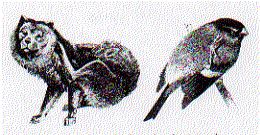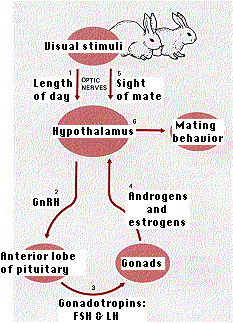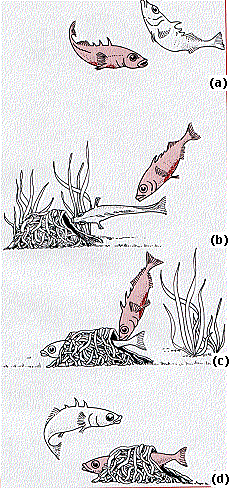| Index to this page |
Behavior is action that alters the relationship between an organism and its environment.
Behavior may occur as a result of| Learned behavior is examined in its own page. Link to it. |
These are the steps:
| Link to a diagram showing these relationships. |
 Instincts are complex behavior patterns which, like reflexes, are
Instincts are complex behavior patterns which, like reflexes, are
The entire body participates in instinctive behavior, and an elaborate series of actions may be involved.
The scratching behavior of a dog and a European bullfinch, shown here, is part of their genetic heritage. The widespread behavior of scratching with a hind limb crossed over a forelimb in common to most birds, reptiles, and mammals. (Drawing courtesy of Rudolf Freund and Scientific American, 1958.)
So instincts are inherited just as the structure of tissues and organs is. Another example.The discovery of the genetic control of foraging in Drosophila began with the observations of Marla Sokolowski when she was an undergraduate biology student at the University of Toronto.
She noticed that Drosophila larvae, feeding in her culture vessels, displayed one of two distinct feeding patterns:After further years of research, she has shown that the behavior is under the control of a single gene, named for ("foraging"). Two alleles are present, at almost equal frequencies, that is, for is polymorphic.
Both alleles encode a PKG, a protein kinase (an enzyme that attaches phosphate groups to target proteins) that is activated by the "second messenger" cyclic GMP (cGMP) [More]. The enzyme encoded by the forR allele is more active than that encoded by fors.
She and her colleagues have succeeded in inserting forR DNA into sitters who promptly become rovers.
Why this polymorphism? Why should alleles for two such different behaviors be maintained at such high frequency in the population?
One possible answer: it permits the population to thrive under varying food conditions:Honeybees have their version of the for gene, called Amfor ("Apis mellifera for")
It, too, encodes a cGMP-dependent protein kinase (PKG).
When worker bees first hatch, they remain in the hive tending to various housekeeping chores, such as feeding the larvae. But when they are 2–3 weeks old, they leave the hive and begin foraging for nectar and pollen.
| Link to discussion of how foraging honeybees navigate. |
This change in behavior coincides with the increased expression of Amfor.
When newly-hatched workers are treated with cGMP,
In many vertebrates courtship and mating behavior will not occur unless sex hormones (estrogens in females, androgens in males) are present in the blood.
The target organ is a small region of the hypothalamus. When stimulated by sex hormones in its blood supply, the hypothalamus initiates the activities leading to mating.
The level of sex hormones is, in turn, regulated by the activity of the anterior lobe of the pituitary gland.
The drawing outlines the interactions of external and internal stimuli that lead an animal, such as a rabbit, to see a sexual partner and mate with it.
 Once the body is prepared for certain types of instinctive behavior, an external stimulus may be needed to initiate the response. N. Tinbergen (who shared the 1973 Nobel Prize with Konrad Lorenz and Karl von Frisch) showed that the stimulus need not necessarily be appropriate to be effective.
Once the body is prepared for certain types of instinctive behavior, an external stimulus may be needed to initiate the response. N. Tinbergen (who shared the 1973 Nobel Prize with Konrad Lorenz and Karl von Frisch) showed that the stimulus need not necessarily be appropriate to be effective.
It is as though she were primed internally for each item of behavior and needed only one specific signal to release the behavior pattern.
For this reason, signals that trigger instinctive acts are called releasers. Once a particular response is released, it usually runs to completion even though the stimulus has been removed. One or two prods at the base of her tail will release the entire sequence of muscular actions involved in liberating her eggs.
Chemical signals (e.g., pheromones) serve as important releasers for the social insects: ants, bees, and termites. Many of these animals emit several different pheromones which elicit, for example, alarm behavior, mating behavior, and foraging behavior in other members of their species.
The mammary glands of domestic rabbit mothers emit a pheromone that releases immediate nursing behavior by their babies (pups). A good thing, too, as mothers devote only 5–7 minutes a day to feeding their pups so they had better be quick about it.
The studies of Tinbergen and others have shown that animals can often be induced to respond to inappropriate releasers. For example, a male robin defending its territory will repeatedly attack a simple clump of red feathers instead of a stuffed robin that lacks the red breast of the males.
Although such behavior seems inappropriate to our eyes, it reveals a crucial feature of all animal behavior: animals respond selectively to certain aspects of the total sensory input they receive. Animals spend their lives bombarded by myriad sights, sounds, odors, etc. But their nervous system filters this mass of sensory data, and they respond only to those aspects that the evolutionary history of the species has proved to be significant for survival.
| Welcome&Next Search |